The Modern and the Perceptions of the Wider Populace
William Fawcett, MA, DipArch, PhD, RIBA
Ian Ellingham, MBA, PhD, OAA, MRAIC
Cambridge Architectural Research Limited,
Unit 6, 23-25 Gwydir Street, Cambridge CB1 2LG, UK
Tel: +44 (0) 1223 460475 www.carltd.com wfawcett@carltd.com ianellingham@carltd.com
This paper is based on one presented at the Conserving the Modern in Canada conference at Trent University, Peterborough, Canada. 6-8 May, 2005. Additions and modifications have been made to the original paper for the purposes of clarification in an online version.
Abstract:
Initiatives to evaluate and manage many aspects of the built environment are often undertaken by
building and conservation professionals without reference to societal attitudes and perceptions. Yet repeated studies have confirmed that the wider population perceives and evaluates the built environment in a manner which can be very different than that of building professionals.
The paper demonstrates how research can further the understanding of how modern architecture is perceived and evaluated by different groups within the wider population. It presents quantitative material collected in two studies about the built environment conducted in the East of England. Policy implications for the conservation of modern buildings are discussed.
Background
Human behaviour should concern everyone who is involved with the built environment – yet serious
research in the area remains limited, and often never makes the transition from academia to practical
implementation. In an architect-dominated context, experimental exploration of human behaviour is
sometimes seen as almost immoral – perhaps a threat to the design autonomy of architects. Over the
past few years Cambridge Architectural Research Ltd (CAR) has been applying tools which are common
in marketing and psychology to improve our understanding of the built environment.
CAR offers a wide range of research and consulting services, including the production of conservation studies. These attempt to establish what is important about heritage buildings, so they can be refurbished or redeveloped appropriately.
One case is New Hall, Cambridge, a women’s college designed by Chamberlin Powell & Bon in 1960-65. Not unexpectedly, its academic denizens kept the files generated during its creation and some of the original participants are still alive, so we could see how the original decisions were made. What was important to the decision-makers? What were the financial limitations and how did they influence the end product? The original participants still felt the idealism of the 1960s, but later occupants were faced with unfinished, run down, unfashionable concrete buildings. Some said that the whole lot should be pulled down. Meanwhile, the buildings had been listed Grade II* on the advice of architectural historians at English Heritage. This is typical: managers and designers are often faced with competing points of view, which are certainly not easy to reconcile, but there is a strong case for finding out more about the occupants' perspectives, something which is typically excluded from conservation discussions.
In a current conservation plan being prepared for the University of East Anglia in Norwich, designed by Denys Lasdun & Partners in 1962-68 and now listed Grade II and II*, anecdotal evidence suggests that the buildings are not widely esteemed. In order to find out more about attitudes to the buildings, a survey of the university community is being run as part of the conservation plan project. It is hoped that this will help in the formulation of a development strategy that will be supported by both the conservation authorities and the University community.
Occupant research
This paper will demonstrate that the behavioural processes which affect buildings can be explored and
even quantified. There are reasons why such an experimental approach has been slow to emerge:
• Buildings are complex, so many of the tools which are used in other areas require modification.
Not all of the methods used by marketing experts and psychologists are easy to apply in our
area.
• Buildings are intertwined with matters of location, which is always a complicating factor.
• The skills necessary to collect and analyse behavioural research data are not usually part of
the skill set of people who deal with buildings.
• The results require careful interpretation.
The investigation of public attitudes is affected by the very long periods of time during which buildings can remain in service. We know from interviews that few fourteen-year-olds will remark about their house being old unless it is pre-First War – they just accept it as where they live. In some places buildings are often casually used for centuries and adapted to serve emerging demands. A couple of years ago a Cambridge student newspaper noted how people had finally recognised what a great performance venue the School of Pythagoras offered – the building was built in the early 1200s.
The long life of buildings means that successive generations form attitudes to the same buildings at different times and under different circumstances. As the generations unfold, buildings acquire successive layers of meaning. One rarely sees cars or clothing of the 1960s on the street – but buildings of that period, and every period back to the mid-Victorian, remain an integral part of our built environment.
The good news is that the public is usually very interested in expressing thoughts about the built environment – which can be a problem in itself, as interviews often become protracted. In one study more surveys came back than were distributed: there had been a one form per house distribution – clearly there was more than one strongly-held opinion in some households.
Recent buildings
The need for increased understanding is particularly high with respect to buildings which are neither old
or new. New buildings are highly regarded because they have been designed to meet current needs,
expectations and fashions. Very old buildings are valued because they simply are old, and often
everything about them is esteemed. But the mixed opinions about post-Second War buildings present a
challenge. Exploration of the relationship between people and buildings is most interesting in buildings
which might be called middle-aged – buildings which are not new, but for which the creating generation
is still around.
A vast quantity of post-Second War construction exists and a few specimens are now being singled out as worthy of conservation. Sometimes, it is not immediately obvious what it is about these buildings which has caused them to be selected. Occasionally, one has the uneasy suspicion that someone from English Heritage just drove by and took a personal fancy to some building. We know that people do perceive things differently – so it is of interest to know how widely shared any subjective attraction to a specific building or building attribute might be.
The buildings we are considering in this paper would probably not be recognised as architectural monuments, but looking at them will contribute to the understanding of other architectural types.
Experiments
I Suburban Office preferences
CAR conducted a study for a developer who wanted to understand why the members of his development
team gave conflicting advice on what style of buildings he should develop. We surveyed people drawn
from a range of groups associated with the creation of office buildings, and also a sample of office users.
We showed the survey participants pairs of photographs of small, fairly ordinary suburban office
buildings and asked them to pick the ones they preferred in each pair. The results showed that there
was considerable disagreement between what the various groups saw as desirable building
characteristics.
Analysing the data, using a form of conjoint analysis, we could quantify how each group responded to three design attributes – roof form, exterior material, and strength of design (Figure 1). The weight given to the different attributes was inferred from the way the respondents evaluated the images of the building types. For example, Users sorted their buildings almost entirely by roof shape; Architects preferred buildings with strong design (the buildings were classified into strong and weak design by a panel of architects); Planners preferred pitched roofs but secondarily preferred the traditional designs, in strong contrast to the Architects’ preferences. Relative to some building attributes, we actually saw sign reversals – some attributes that were seen as desirable by Architects were seen as undesirable by Planners.
Figure 1
We could also see how each group tended to agree or disagree with the other groups (Figure 2). The findings of this research should be a caution to architects – they react to buildings in ways which are very different than the wider population, so architects cannot act as a proxy for the genral public. This suggests that the use of specialists alone to set conservation policies is inappropriate.
II House type evaluation
Another study considered public attitudes towards house types available in the East of England, ranging
from mid-Victorian to current developer houses, including post-Second War architect-designed houses
and some currently-popular reproduction houses. Two aspects of this large study are of interest here.
The participants evaluated photographs of the house types both in an overall sense and with respect to eighteen semantic differential scales. The survey encompassed 1,491 respondents, representing a range of ages and socio-economic groups. They provided 6,201 individual house evaluations.
Figure 2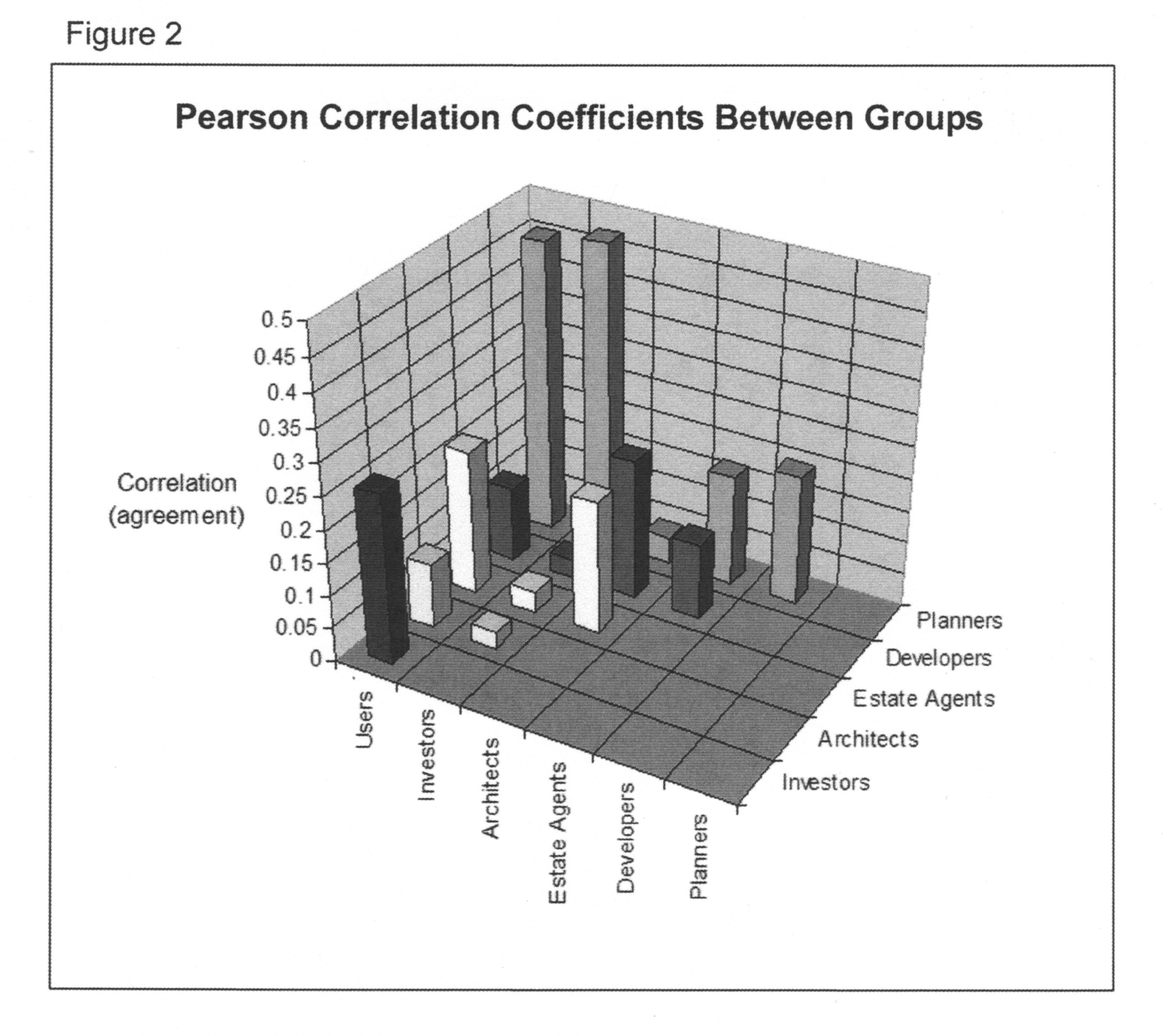
Interviews were also undertaken, particularly with older individuals: people over 90 are fascinating and often delightful subjects, but many have infirmities which limit their ability to deal with paper forms. Some subjects were over 100 and one identified a house he had seen when it was under construction – in 1919. There is much evidence that value systems are formed when people are in their twenties, and once formed, remain more-or-less fixed. This allows one to look back in time. Older subjects may be more familiar with their early life than with the present (one psycho-medical test is to ask the name of the prime minister: when the response is Lloyd George or Arthur Meighan you may have found a wonderful time capsule) – so they are likely to express exactly what they thought when they were in their 20s or 30s.
Interwar houses
Houses of the Interwar period are of particular interest because they have gone from new, to not
new/not old, and are now moving into the old and esteemed category. In addition, it was possible to
collect a long history of opinion, including some people who moved into them when they were new.
Two basic types of Interwar houses were considered (Figure 3). The Interwar ‘builder’ houses were the first form of houses in the UK built specifically for owner occupancy – before the First War, virtually all houses in the UK were rented. The Interwar ‘council’ houses were often better-constructed; they were built for subsidised rental, but many have been owner-occupied for decades.
Figure 3
Interwar vs. other houses: Overall Scoring
The evaluation of the different house forms changes through the generations (Figure 4). One sees the Victorian houses rising from a level of contempt with older people to first place with younger people, and the fall of the Interwar builder house from first place among the oldest groups to near the bottom with younger people. The Interwar builder house, unlike the Victorian and the Interwar council houses, does not yet show an increase in esteem. Photographs of sample house types are included as Appendix 1.
Figure 4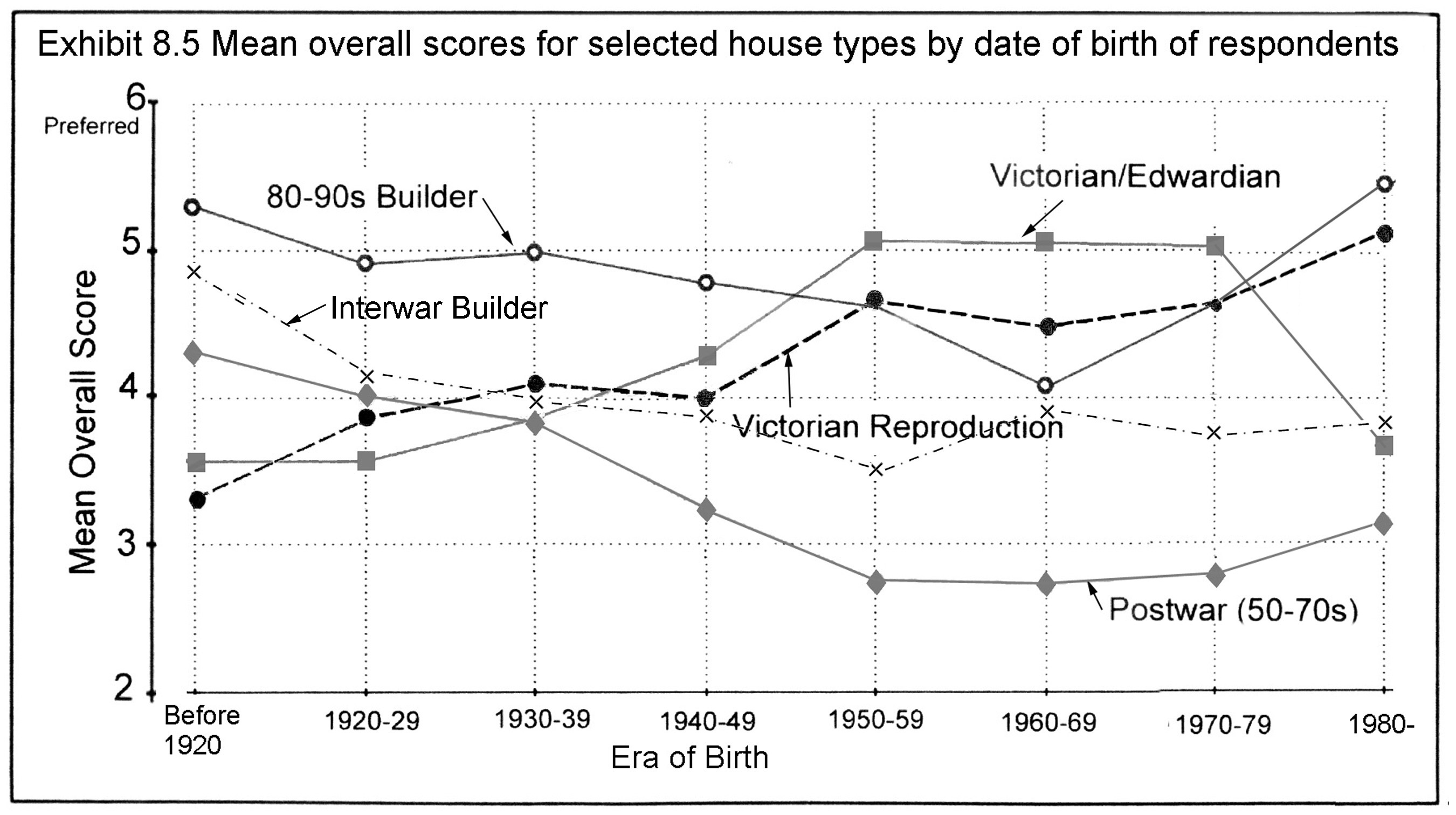
The Interwar council type has become very popular among people aged 20 to 40, today's active house consuming generation. When built, these houses were seen to be a vast improvement over the private rental Victorian stock, and the oldest groups rank them quite highly. Subsequent cohorts scored them lower: they were no longer new, and being council houses were of lower status than owner-occupied. Today, younger consumers are unaware that they were ever council stock and evaluate them without that knowledge.
The modern post-Second War (1950-70s) houses scored quite high among the 60+ groups – the people who bought them originally – but the younger groups regard them with distaste. If history does repeat, this type should rise in esteem in a few decades, as the Victorian and Interwar houses have done.
The group born between 1930 and 1939 do not differentiate much between the house forms, except they clearly like the newest suburban builder houses and dislike the architect-designed 'high-style' houses. They were brought up under the grumbling economy of the depression, through the war, and into post-war austerity, when the building stock received little investment. When they were forming their values, most people in this cohort aspired to a waterproof roof, indoor plumbing and, believe-it-or-not, electricity. Other non-utilitarian attributes of a house understandably meant (and still mean) little to them.
The scores for architect-designed houses – perhaps the most ‘modern’ in the survey – were grouped together, but the designs were much more varied than the other types. Some were regarded reasonably highly, but were overwhelmed by those which were despised by virtually everyone. Some of the responses suggested that the non-traditional detailing of some of the architect-designed houses result in a perception of poor serviceability and durability. One new, low-scoring architect-designed house came up for sale during the study, and although it was located in a popular neighbourhood, had wonderful interior finishes, and was apparently reasonably priced, it took months to sell – while the surrounding Victorian houses were snapped up in a booming market.
An emerging house form was not tested – the Interwar reproduction. Perhaps one mark of increasing regard is when reproductions start to be built. The Victorian reproductions were esteemed by the 20-30 year-old respondents, who clearly recognised them as reproductions but did not mind. Will Interwar reproductions become as popular?
Window Replacements
Houses undergo modification to reflect changing consumer expectations – an adaptation to conform to
emerging values and preferences. How different groups regard 'improvements' can give valuable
insights.
In the earlier stages of the study, inadvertently, the photos of some Interwar houses had the original windows and others had non-original replacements, leading to the inconsistent results. Subsequently, modified photographs were used (Figure 3) showing the same house with original windows and with typical replacement ‘picture’ windows, for both Interwar builder and council houses. There were a total of 1,475 individual responses to these images.
Window modifications changed the overall evaluation of the houses (Figure 5). For Interwar builder houses (the black lines), the younger age groups gave higher overall scores to the houses with the original windows, while respondents over 60 scored the houses with replacement windows higher. A somewhat similar pattern appeared for the Interwar council houses (the grey lines). However, the lines for council houses do not cross, perhaps because without glazing bars these houses become quite featureless, while the builder houses retain some character. We included the under 20s here: they showed no clear pattern of opinion, suggesting this is a response that young people have not yet acquired.
Figure 5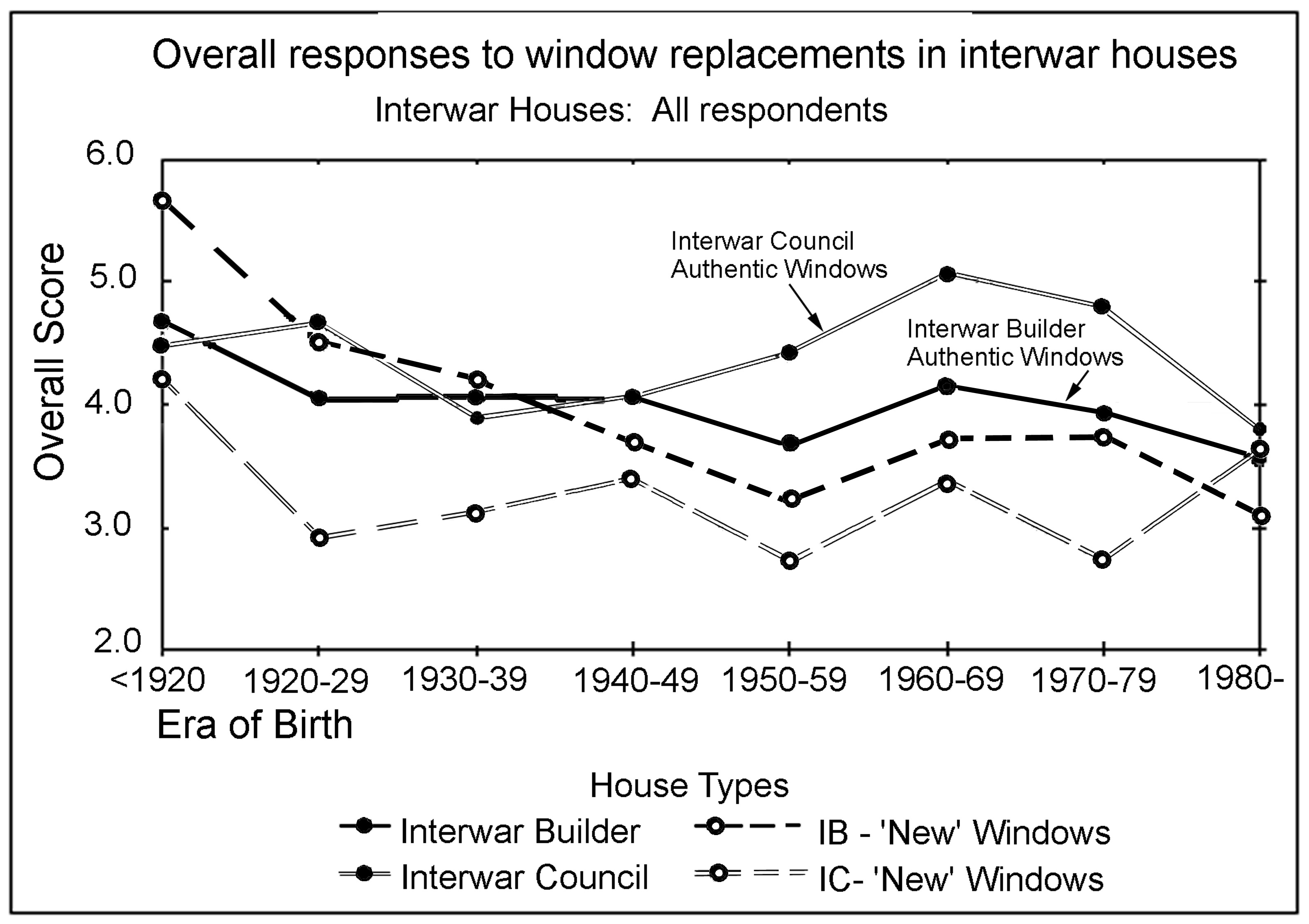
This is not the entire story. The respondents were also classified according to occupation, most falling into ‘Service’ (professional, and administrative & managerial), ‘Intermediate’ (clerical and sales), and ‘Worker’ (Technicians & supervisory, skilled labourers, and manual labourers) classes.
With respect to the window replacements, it was found that responses were dependent upon occupational category as well as age (Figure 6). Both Service and Worker respondents aged 60 and over scored the Interwar builder houses with the replacement windows higher. Both groups aged 35-59 preferred the houses with the original windows. However, among those aged 20-34 the Worker respondents preferred the houses with replacement windows, while the preference for the original windows increased for the Service respondents. One can go into more detail. For example, Figure 7 shows data about the perceived status of Interwar builder houses for the Intermediate respondents.
Figure 6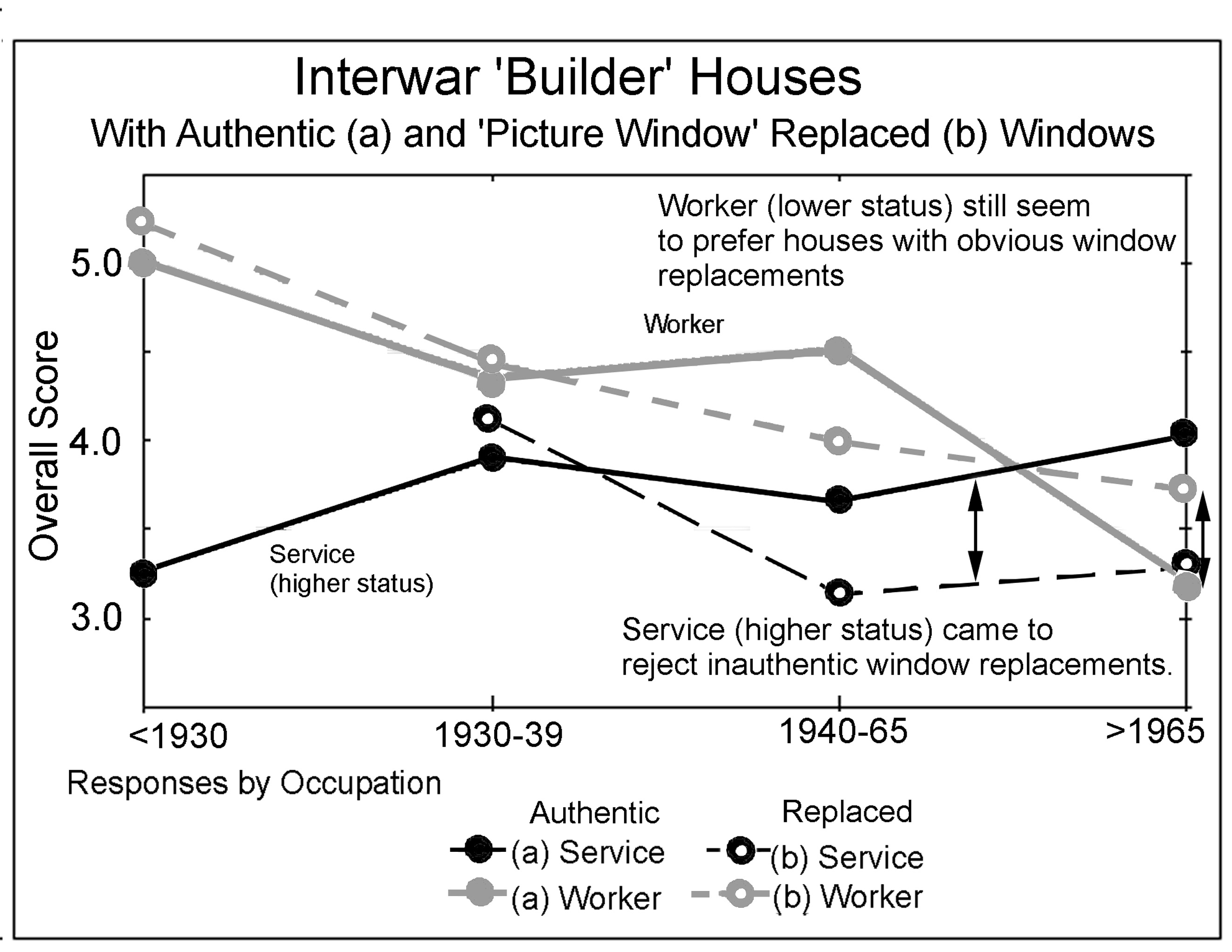
The response to the house with the original windows remained stable over the generations, while the response to replacement windows has changed dramatically. The older consumers see the houses with the picture window replacements as more prestigious, while the younger consumers see them as less so.
What appears to be occurring is that for the typical older individual the worth of an Interwar house is increased when windows are replaced, because ‘functionality’ is enhanced. Younger groups believe picture windows have a negative impact on the ‘prestigiousness’. One might hypothesise that some older groups believe that having obviously new windows enhances prestige, perhaps as a display of wealth, or being ‘clean’, ‘light’, and ‘up-to-date’. To the younger Service person, prestigiousness derives from some other attribute, perhaps historical authenticity, which is diminished by inappropriate window replacements. There is a difference between the social and age groups’ responses to functionality and in particular the ‘inexpensive to maintain’ scale. This was most important to young Worker respondents who appreciate the lower heating and maintenance costs implied by the replaced windows. They should be the most cost-sensitive group, having young families and mortgages, yet a limited income.
Figure 7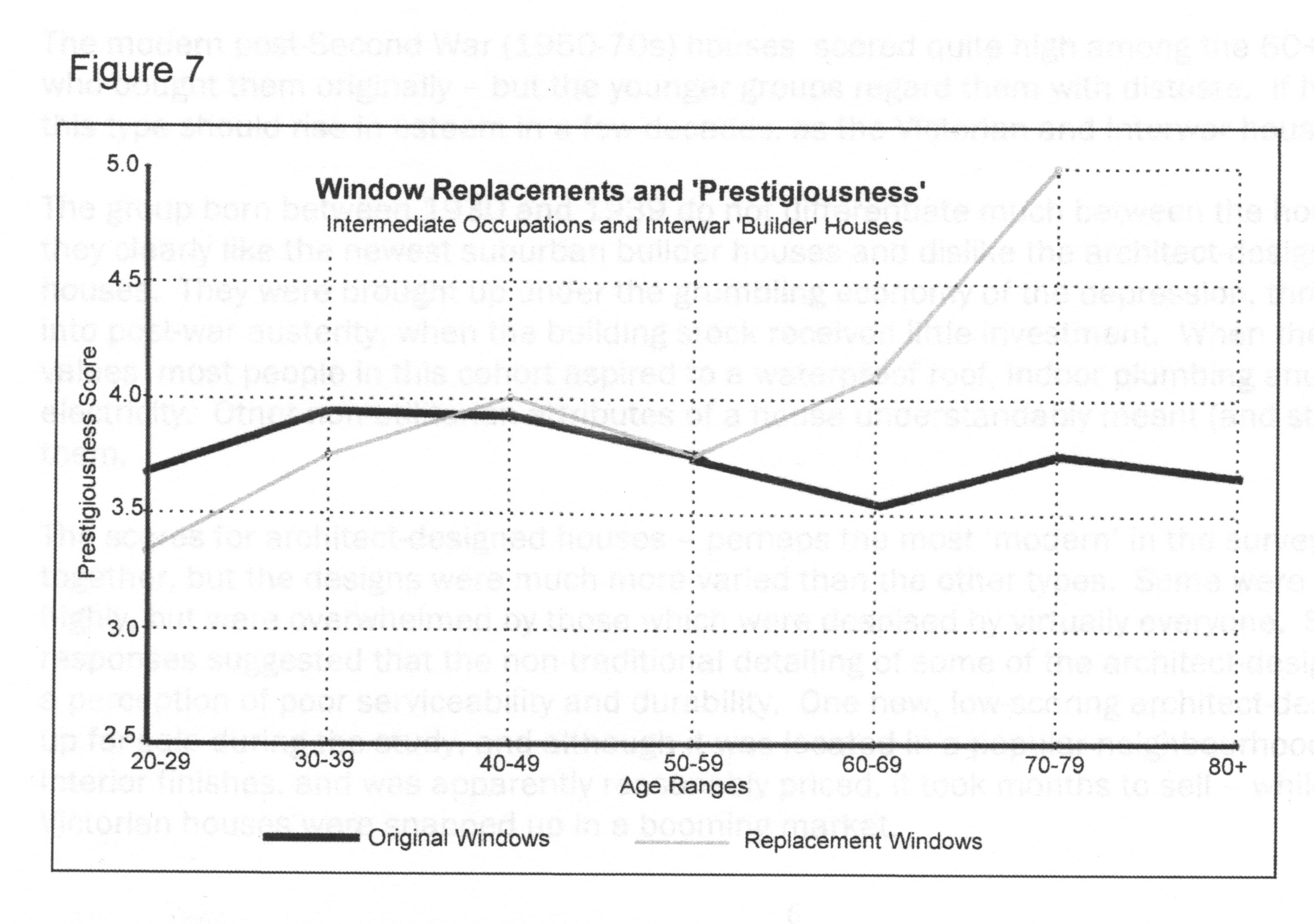
Window Replacement Discussion
Clearly one has to be aware of the changing composition of the population. Currently, the market
preference for original windows (or good-quality reproductions) is driven by the preponderance of people
now in Service occupations, who, in the survey expressed their preference for them.
This accords with field observations: in more affluent areas the Service consumers show concern with historical authenticity (original-style windows are sometimes reinstated), in contrast to lower income neighbourhoods where many households continue to replace deteriorating original windows with replacement picture windows.
Subjective opinions about whether replacement picture windows are attractive or ugly vary greatly – but opinions do rely on a basis of knowledge. Most Canadians will lack the historical knowledge to even notice the window replacements in the Interwar UK housing stock. The Canadian conducting the experiment stumbled across the phenomenon while analysing preliminary survey results, and subsequently acquired a horror of inappropriate window replacements. This lack of relevant knowledge is paralleled in the responses of under 20 year-olds, because, with rare exceptions, data from them was a chaotic jumble – yet by the time people reach their mid-twenties they exhibit firmly held opinions. This suggests that preferences are largely acquired, not innate, but we know very little about how they are formed.
Conclusions
The studies reported here regarding the esteem attached to buildings by different groups of people
indicate, firstly, that architects may have a different set of values than the wider populace, but secondly,
that within the populace at large, there exists range of personal values depending on such attributes as
age and social background. When considering the conservation of buildings that are not universally
esteemed – as is the case for ‘not old/not new’ buildings – what does this tell us about whose values
should guide policy?
The objective of architectural conservation is to ensure that future generations will experience heritage places and buildings that give them edification and pleasure. Therefore, future generations’ values should be decisive – if they could be anticipated. A rather brutal implication might be to argue that the values of the older generations today should carry little weight – but it is this generation that is often most active in amenity societies and conservation pressure groups. The values of younger people, and the trends that are revealed in the differences between the attitudes of older and younger people today, might be a more useful guide to policy.
A good understanding of the relevant values could assist in identifying which buildings in which locations are most worth conserving, and which particular features should be conserved if, as is usually the case, some changes have to be made even to heritage buildings to allow them to remain economically viable.
One finding of the housing survey was that, after a decrease, esteem offered to buildings increases as the buildings get older (relative to a specific cohort's own age). If this pattern continues, post-Second War building will become increasingly esteemed by succeeding generations – until eventually all buildings of the period will become valued, as all Victorian and pre-Victorian buildings are indiscriminately esteemed today. If this is true, perhaps it does not really matter what buildings survive. Arguably, therefore, future generations are unlikely to be grateful for architectural conservation that conflicts with economic growth: they will like whatever buildings survive, but resent any lowering of their standard of living. On the other hand, conservation that leads to the survival of assets that turn out to have long-term economic value will be beneficial to future generations (as is the case for Venice, perhaps).
We have demonstrated that there are powerful research tools for learning about human attitudes towards buildings and the built environment, and such exercises should help in the management of the building stock over time. Even though architects and experts involved in managing the built environment sometimes feel threatened by such explorations, other disciplines do expend considerable resources to understand the behaviour of the wider population – perhaps politics can serve as an example. Many studies are undertaken of the electorate, but the politicians do not always align exactly with the findings – they have to interpret results before taking positions. Conservation will never be easy, but we argue that better understanding of the attitudes of the wider populace can only lead to better conservation policy.
APPENDIX 1: SAMPLE OF TYPICAL HOUSE TYPES USED IN SURVEY
RELATED READINGS:
Ainley, P. (1993). Class and Skill, Changing Divisions of Knowledge and Labour. London: Cassell.
Amerigo, M., and Aragones, J.I. (1997). A Theoretical and Methodological Approach to the Study of
Residential Satisfaction. Journal of Environmental Psychology, 17, pp.47-57.
Arias, E.G. (1993). User Group Preferences and their Intensity: In Arias, E.G. (Ed.), The Meaning and Use
of Housing, International perspectives, approaches and their applications. Aldershot, U.K.: Avebury
Publishing Limited, pp.169-199.
Bechtel, R.B., and Korpela K..M. (1995). Most Happy and Most Depressing Places: A Finnish-U.S.
Comparison. In Nasar, J.L., Grannis P., and Hanyu K. (Eds.), EDRA 26 Conference 1995, Oklahoma
City, pp.80-86.
Belk. R.W. (1991). Situational variables and consumer behavior. In Ennis, B.M., Cox, K.K., and Mokwa,
M.P. (Eds.). Marketing Classics, eighth edition. Upper Saddle River, N.J.: Prentice Hall International.
Originally published in Journal of Consumer Research, (Dec. 1975), pp.157-164.
Earl, P. (1986). Lifestyle Economics: Consumer Behaviour in a Turbulent World. Brighton: Wheatsheaf
Books.
Goodchild, B. (1974). Class differences in environmental perception: an exploratory study. Urban Studies,
11, pp.157-169.
Hershberger, R.G. (1970). A study of meaning and architecture. Reprinted in Nasar, J.L. (Ed.), (1988).
Environmental aesthetics, Theory, research and applications. Cambridge: Cambridge University Press.
Hershberger, R.G., and Cass, R.C. (1988). Predicting user responses to buildings. In Nasar, J.L. (Ed.),
(1988), Environmental aesthetics, Theory, research and applications. Cambridge: Cambridge
University Press, pp.195-211.
Light, D., and Prentice, R.C. (1994). Who Consumes the Heritage Product? Implications for European
Heritage Tourism. In Ashworth, G.J., and Larkham P.J. (Eds.), Building a New Heritage: Tourism,
Culture and Identity in the New Europe. London and New York: Routledge, pp.90-116.
McFadden, D. (1986). The Choice Theory Approach to Market Research. Marketing Science, 5 (4). Fall
1986, pp.275-297.
Nasar, J.L. (Ed.), (1988). Environmental aesthetics, Theory, research and applications. Cambridge:
Cambridge University Press.
Nasar, J.L. (1989). Symbolic Meanings of House Styles. Environment and Behavior, 21(3), pp.235-257.
Nasar, J.L. (1994). Urban Design Aesthetics: The Evaluation of Building Exteriors. Environment and
Behavior, 26(3), pp.377-401.
Osgood, C.E., May, W.H., and Miron, M.S. (1975). Cross-cultural Universals of Affective Meaning. Urbana:
University of Illinois Press.
Proshansky, H.M., Fabian, A.K., and Kaminoff, R. (1983). Place-Identity: Physical World Socialization of
the Self. Journal of Environmental Psychology, 3, pp.57-83.
Purcell, A.T. (1984a). The Organisation of the Experience of the Built Environment, Environment and
Planning B: Planning and Design, 11 pp.173-212.
Quigley, J.M. (1987). Consumer Choice of Dwelling, Neighborhood and Public Services. Regional Science
and Urban Economics, 15 (1), pp.41-63.
Sadalla, E.K., and Sheets V.L. (1993). Symbolism in Building Materials; Self Representative and Cognitive
Components. Environment and Behavior, 25(2), pp.155-180.
Sanoff, H. (1970). House Form and Preference. In Archer, J., Eastman C. (Eds.), EDRA 2 Conference.
Pittsburgh, pp.334-339.
Scitovsky, T. (1992). The Joyless Economy: The Psychology of Human Satisfaction. Oxford: Oxford
University Press.
Stamps, A.E. III. (1998). Measures of architectural mass: from vague impressions to definite design
features. Environment and Planning B, 25 (6), pp.825-836.
Stamps, A.E. III, and Nasar, J.L. (1997). Design Review and Public Preferences: Effects of Geographical
Location, Public Consensus, Sensation Seeking, and Architectural Styles. Journal of Environmental
Psychology, 17, pp.11-32.
Tarlow, S. (1999). Strangely Familiar. In Tarlow, S., West, S. (Eds.), The Familiar Past? Archaeologies of
later historical Britain. London: Routledge, pp.263-272.
Uzzell, D.L. (Ed.). (1989). Heritage Interpretation, Volume 1: The Nature and Built Environment. London:
Belhaven Press.
Wilson, M.A. (1996). The Socialization of architectural preference. Journal of Environmental Psychology,
16, pp.33-44
Post a Comment